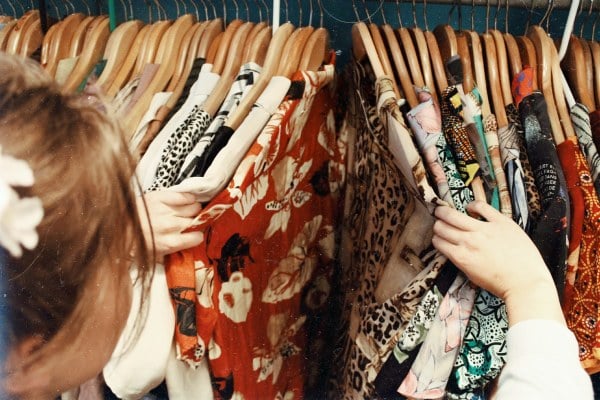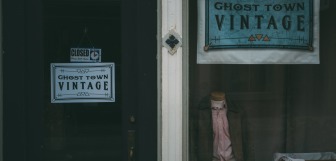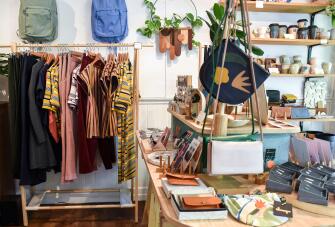Starting an Online Thrift Store: Top 10 Tips
Considering that in 2020, the global market value of the secondhand and resale apparel sector was estimated to be worth $27 billion, it's clear there's no better place than thrift stores to get (Mackle)more for your money. And that doesn't just go for customers[1].
While many find the concept of owning a profitable thrift store... bazaar, these stores actually allow for extremely low-cost margins, which work to ultimately maximize your profits, so it's really a win-win.
With customers more reluctant to shop on the high street post-pandemic, many are moving online. Due to the number of thriving thrift shops already in the market, these entrepreneurs often opt for selling through existing platforms over setting up their own online thrift stores. However, success doesn’t have to be second-hand. Starting an online thrift store yourself can start making sense, with a few simple steps.
 What is a thrift store?
What is a thrift store?
Simply put, a thrift store is an outlet for pre-loved goods and clothing. Ranging widely from charity shops to vintage boutiques, these various thrift store setups do have one uniting factor - they sell pre-owned items at discounted prices, compared with retail outlets and department stores.
It's not difficult to see the appeal of cheap, quality items at a fraction of their original cost. However, while the value proposition might be simple, starting a thrift store is far from straightforward. If you find formulating a plan problematic, don't fret, we've put together a list of 10 top tips to get you going in the right direction:
Research
As with any retail venture, research is key. You may have a great idea for starting an online thrift store, but you should always do your due diligence. Since your store will be located solely online, you'll now be competing globally for custom.
From a customer's viewpoint, you should look at what your online competitors are doing and how they're performing, analyze what works, and where can you offer value in comparison. You should also research your target market, to understand their buying habits and preferences. This will help you tailor your offering accordingly.
Find your niche
As with starting any business online, it's important to identify your niche. Since customers have access to a world of online thrift stores at their fingertips, it's crucial to identify where you can offer something unique and/or superior to other retailers in the same space.
This might be through sourcing and stocking a particularly unique range of products, or by specializing in certain types of items (vintage clothing, for example). You could also focus on a specific demographic, such as young adults or retirees.
Create a brand identity
A thrift store is only as good as its reputation and this starts with your online branding. You'll want to create a strong branding strategy and develop a logo that is recognizable and appealing to stand out amongst your competition in customers' minds.
Your website design should mirror your brand identity - the layout and style should be eye-catching but not too busy, as well as easy for users to navigate. The tone of voice you choose for your social media posts, emails and blog content, is also important - it should be consistent with your brand identity.
Since starting an online thrift store is often a relatively low investment venture, you might be pleased to know that there's a wide range of free online tools like Wix and Canva, which can help you create a professional logo and website design.
 Set up shop
Set up shop
There are three main options for setting up: you can create your own website, use an existing online marketplace or set up shop on social media platforms. Each of these has its own advantages and disadvantages:
- Creating a website will give you more control over the look and feel of your store, but it can be more time-consuming and expensive to make and maintain.
- Using an online marketplace is a good option if you're starting out as they provide all of the necessary infrastructure and support, but you'll be competing with other retailers on their platform.
- Setting up shop on social media platforms is free and easy to do, but you'll be limited by social media algorithms, which can make it harder for customers to find your page.
Whichever option you choose, it’s important to remember that you’ll still need to manage the day-to-day running of the business yourself.
Invent your inventory
Once you've decided on your business model, it's time to start stocking your store. You'll need to decide what specific items you want your store to and whether you're going to source products yourself, or if other people will be able to sell their own items through your website.
When starting out, choosing the former model (known as dropshipping) is recommended - you'll have more control over what is sold in your store and how it's presented.
While starting out with this model might require a larger initial investment since you'll need to purchase your products up-front, you can keep costs low by sourcing your items from garage sales or managing to get them donated free of charge.
This model is excellent for selling more unusual or high-quality items - it's harder for other people to source the same brand of vintage clothing that you've sourced from France for example.
Sort out your storage system
It's important to have a good storage system in place for easy inventory management.
If you have a lot of stock, it can be helpful to sort it into categories like size, colour or style, so that you know exactly where everything is when customers ask about specific items. You should also make sure that you have enough space to store it all safely and securely - ideally in a dedicated room or spare bedroom.
As your store starts to grow, you'll quickly realize that business organization is key. Organizing your stock will help streamline the packing and delivery process and keep track of what's been sold and what needs to be restocked.
 Perfect your pictures
Perfect your pictures
One of the most important aspects of an online store is the quality of its product photos.
When starting out, it's a good idea to take high-quality photos yourself - this helps set your store apart from the competition and gives your customers a clear idea of what they're buying.
If you don't have the time or resources to take your own photos, you can outsource this task to a professional photographer. All photos should be well-lit, showcasing the product in the best possible way, ideally on and off your models.
Price your products
Improper pricing strategies can see your profits going off the rails... literally. If you're too expensive, customers will be less likely to buy from you; but if you're too cheap, then you might not make as much profit as you'd like. Ideally, you should aim to be the same price as other similar stores, or slightly cheaper if you can afford to do so.
Set up shipping
Depending on how much stock you have, starting an online thrift store might mean that a large proportion of what you sell will be sent via courier or postal service, such as Royal Mail. In this instance it's important to have a solid shipping policy in place, outlining how much you charge for postage and how long it will take for products to arrive.
When starting out, it's a good idea to set up your store with free shipping and/or provide tracking information for customers who are worried about their order arriving safely, to encourage sales and build brand loyalty.
Put the pro in promo
No matter how great your products and branding might be, you won't make any sales if no one knows about your store. Although starting an online thrift store is relatively low cost, you might choose to set aside some budget for paid ads on social media platforms and Google.
These are a great way of reaching your target audience with ease and getting them to click through to your site or social media page. You can also promote yourself through social media - hosting competitions and raffles across your accounts, creates a buzz around your new business.
Have an outlet for your thrift store statistics with a POS system
When building a new business, you’ll need strong foundations to support your growth. Epos Now's point of sale (POS) systems work as the backbone of retail businesses for a number of reasons. Designed to offer complete business management, we let you choose your tools and insights, so you can control all vital aspects of your company from one cloud-based system:
- Filter sales reports by individual product, profit margin, trending items, or employee
- Multi-award-winning inventory management that syncs online sales and in-person sales for the most up-to-date stock levels
- Create your own website or integrate with a fully loaded ecommerce platform
If you want to find out more, request a free callback with one of our experts.




